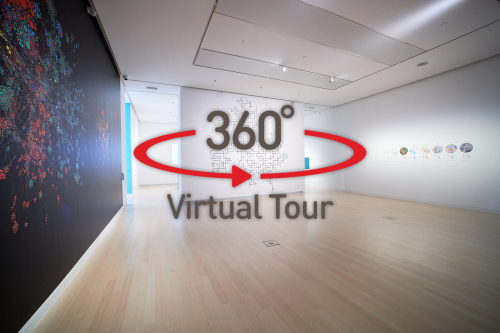The exhibition is open: 10. October, 2020 – 20. June, 2021
BarabásiLab: Hidden Patterns
The Language of Network Thinking
The exhibition Hidden Patterns. The Language of Network Thinking aims to present the last 25 years of research of BarabásiLab, led by physicist and network researcher Albert-László Barabási. By following the development of network visualization – through presenting the main projects of the BarabásiLab – the viewer can finally gain insight into the application of this comprehensive method in art. Using state-of-the-art technology, network diagrams and structures vividly describe the hidden connections and relationships that underlie the studied phenomena. The exhibition is a novel, exciting attempt to present scientific findings in a museum setting.
This exhibition is a peculiar being in the life of the Ludwig Museum: a chimera that simultaneously preserves the methods and approaches of several different types of knowledge. It is a mosaic woven of science and art, where some elements of the two media are often interchanged and new shoots are developed, new patterns are created.
“The study of the current matrix of science and art is a fundamental guideline for our museum, and our conferences and exhibitions on media art and contemporary art over the past seven years have all served to make room for the ensemble of art and science, that is, for interdisciplinary phenomena, and to lay the foundations for the methodology of their coexistence.”
Dr. Julia Fabényi, Director of Ludwig Museum – Museum of Contemporary Art
Both activities – visualization in each discipline, respectively the creation of artworks – fit into the same comprehensive set, the vast realm of visual expression. In other words, the phase of visualization is a key moment in both processes, i.e., visualization plays the role of a common denominator in relation to natural sciences and other segments of culture.
“At Magyar Telekom, we are constantly building and operating networks and are convinced that our networks and services contribute to the development of society. However, we have to admit that we cannot say – at most we guess – what changes are triggered at the societal level by these complex connections. This question is beyond our reach, as it belongs to the field of natural and social sciences, future studies, and the arts. A researcher’s curiosity and a creative vision are needed to think about these topics, and the exhibition of Albert-László Barabási helps to understand what science says and what art says about networks and the future,” István Kutas, the corporate communications director at Magyar Telekom said, as the main sponsor of the exhibition.
Art itself has been using complex visual diagrams, information graphics for decades, which are not necessarily artefacts, but often seek to display connections, processes, origins, degrees of kinship, or other relationships. The images and figures of Barabási’s scientific projects have so far appeared mainly in a context in the lifeworld of art where they could represent a topic as a given cultural practice (e.g. mapping, mind maps etc.). The visualization models are presented independently, based on their own logic, at the Ludwig Museum in Budapest and then at ZKM in Karlsruhe.
BarabásiLab’s research focuses on the search for mostly invisible connections between things and phenomena, the exploration of repetitive patterns, which connect nature, society, language and culture. This network approach promises a comprehensive, universal method that can be used to examine almost any context (e.g., the success of artistic careers) with scientific precision. Through the use of virtual and real data sculptures and tools based on augmented reality, images projected into space offer new possibilities for visualization for researchers and those interested.
The exhibition will include the presentation of ongoing research processes and analyses, such as the display of the Global-Local Art Network, which depicts the relationships between artists and institutions, or even the impact of the COVID-19 pandemic on human communication.
In fact, the stake of the exhibition is whether it succeeds in bringing the spirit of network thinking closer to the lifeworld of art and those interested, with proper sensitization. Barabási’s network visualization as a method is already present among the possible tools of contemporary art in many respects. It is an opportunity and potential that would be foolish for us not to take into account…
The staircase connecting the exhibition spaces houses Albert-László Barabási and Brazilian-born Edson Pavoni’s monumental modular system, which illustrates the connections between data sculptures made in 2D or in a much smaller dimension. The large-scale space construction is based on the network of the Hungarian art scene.
The Network Drawing Robot and the Extended Data Sculpture Application are implemented in collaboration with the Emergens Media research group of MOME Innovation Center and the BarabásiLab. Every day of the exhibition, the Robot draws the network of one of artist’s life path from the contemporary Hungarian art scene, while the Extended Data Sculpture Application supports the understanding of the hidden information behind the network sculpture with the help of Augmented Reality.
The exhibition is accompanied by a number of professional and museum educational programs, which have been supported by partners such as Bridge Budapest, the British Council, the Kürt Academy and Edisonkids.
An English-language catalogue of the exhibition will be published by Hatje Kantz.
Following the presentation in Budapest, the exhibition will be on view at ZKM – Zentrum für Kunst und Medien Karlsruhe from 27 February to 8 August 2021.
Curator: József Készman
The catalogue published jointly with Hatje Cantz will be also presented during the event.

![]()
BarabásiLab
Center for Complex Research (CCNR)

The exhibition is organised as part of the CAFe Budapest Contemporary Arts Festival.

Main sponsor: Magyar Telekom
Sponsors and partners:






























